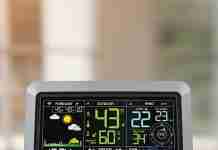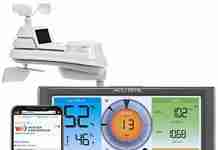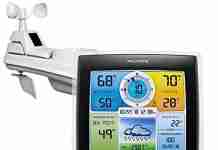When a hurricane approaches, meteorologists issue two important alerts: a watch and a warning.
While these terms may seem interchangeable, they have different meanings and implications. Understanding the difference between a hurricane watch and a warning can help people prepare and stay safe during a storm.
A hurricane watch is issued when a tropical cyclone containing winds of at least 74 MPH poses a possible threat, generally within 48 hours.
A watch does not mean hurricane conditions will occur, only that these conditions are possible. Hurricane-force winds may accompany storm surges, coastal and river flooding.
On the other hand, a hurricane warning means that hurricane conditions are expected and could occur within 36 hours or less. When a warning is issued, people should immediately protect themselves and their property.
It is important to note that hurricane watches and warnings differ from hurricane advisories. Advisories are issued every six hours and provide information about a storm’s location, strength, and movement.
Watches and warnings are issued less frequently and are meant to alert people to potential hazards and risks.
By understanding the difference between a hurricane watch and a warning, people can make informed decisions about preparing for and responding to a storm.
Review contents
Understanding Hurricanes
Hurricanes are one of the most influential and destructive natural disasters that can occur.
They are tropical cyclones that form over warm ocean waters and can bring strong winds, heavy rain, storm surges, and flooding to coastal areas.
Formation of Hurricanes
Hurricanes form when warm, moist air rises from the ocean’s surface and begins to cool, causing water vapor to condense into clouds.
As warmer air rises and cools, a low-pressure system is created, and winds circulate it.
If the conditions are right, this system can continue to grow and intensify, forming a hurricane.
Stages of Hurricanes
Hurricanes go through several stages as they develop and move across the ocean. The National Hurricane Center (NHC) categorizes hurricanes based on their wind speed using the Saffir-Simpson Hurricane Wind Scale.
The scale ranges from Category 1, with winds of 74-95 mph, to Category 5, with winds over 157 mph.
As a hurricane approaches land, it can bring dangerous storm surges, walls of water pushed ashore by the storm’s winds. Heavy rain and flooding can also occur, causing significant damage to homes and infrastructure.
When a hurricane is approaching, paying attention to the difference between a hurricane watch and a hurricane warning is important.
A hurricane watch means hurricane conditions are possible within the next 48 hours, while a hurricane warning means hurricane conditions are expected within the next 36 hours.
In either case, it is essential to prepare for the storm, such as securing loose items outside, stocking up on food and water, and planning evacuation if necessary.
Hurricane Watch
Definition
A hurricane watch is issued when hurricane conditions, including sustained winds of 74 mph or higher, are possible within a specified area.
The National Hurricane Center typically issues a watch about 48 hours before the expected onset of tropical-storm-force winds, sustained winds of 39 to 73 mph.
During a hurricane watch, individuals should begin to prepare for the possibility of a hurricane. Monitoring the weather conditions closely and staying up-to-date with the latest weather forecasts and advisories is essential.
Preparation Steps
When a hurricane watch is issued, individuals should take the following steps to prepare for the possibility of a hurricane:
- Review their emergency plan and ensure they have all the necessary supplies for at least three days, including food, water, and medication.
- Secure their home by covering windows and doors with storm shutters or plywood.
- Bring any outdoor furniture, decorations, or other items that could become projectiles in high winds.
- Charge all electronic devices, including cell phones, laptops, and portable chargers.
- Fill up their car’s gas tank.
- Stay informed about the latest weather conditions and advisories by listening to the radio, watching the news, or using a weather app.
It is important to note that a hurricane watch does not mean that a hurricane is imminent. However, it is crucial to take the necessary steps to prepare for the possibility of a hurricane.
Hurricane Warning
Definition
A hurricane warning is a weather advisory issued by the National Hurricane Center (NHC) when hurricane conditions, including sustained winds of at least 74 mph or higher, are expected within a specified area.
The NHC typically issues these warnings 36 hours before tropical-storm-force winds are expected to arrive.
Actions to Take
If a hurricane warning has been issued for your area, you must immediately protect yourself, your family, and your property. Here are some steps to take:
- Follow the instructions of local authorities and emergency management officials.
- Evacuate if you are in a low-lying or mobile home, as these areas are particularly vulnerable to storm surges and flooding.
- If you cannot evacuate, move to a designated shelter or a safe room.
- Secure your property by boarding windows and doors, bringing in outdoor furniture and other loose objects, and turning off utilities.
- Stock up on food, water, and other emergency supplies, including a first aid kit, medications, and essential documents.
- Stay informed by monitoring local news and weather reports, and be prepared to take additional action if conditions worsen.
Remember, a hurricane warning means that hurricane conditions are expected in your area, and you should take all necessary precautions to protect yourself and your property. By following the guidance of local authorities and emergency management officials, you can help keep yourself and your loved ones safe during a hurricane.
Critical Differences Between Watch and Warning
Time Frame
The primary difference between a hurricane watch and a warning is the time frame they are issued. According to the National Hurricane Center (NHC), a watch is typically issued 48 hours before anticipated tropical-storm-force winds. This gives individuals and communities in the affected areas enough time to prepare for the storm.
On the other hand, a warning is issued when hurricane conditions are expected within 36 hours. This means that individuals and communities should already have completed their preparations and should be taking immediate action to protect themselves and their property.
Recommended Actions
When a hurricane watch is issued, individuals and communities should take the following recommended actions:
- Stay informed by monitoring local news and weather reports
- Review and update emergency plans and supplies
- Secure loose outdoor items and prepare to bring them inside
- Fill up gas tanks and stock up on food, water, and other essential supplies
When a hurricane warning is issued, individuals and communities should take the following recommended actions:
- Evacuate if instructed to do so by local authorities
- Follow all emergency instructions and evacuation orders
- Move to higher ground if in a flood-prone area
- Stay indoors and away from windows during the storm
- Keep a battery-powered radio on hand to stay informed about the storm’s progress
It is important to note that hurricane watches and warnings are not guarantees of specific weather conditions. Instead, they will provide individuals and communities enough time to prepare for a potential hurricane.
Conclusion
Understanding the difference between a hurricane watch and a hurricane warning is critical for anyone living in a coastal area. A hurricane watch means conditions are possible, while a hurricane warning means hurricane conditions are expected within 24 hours.
During a hurricane watch, people should prepare for the possibility of a hurricane by gathering supplies, securing their homes, and making evacuation plans.
If a hurricane warning is issued, people should immediately protect themselves and their property.
This may include evacuating the area, boarding windows and doors, and moving valuable items to higher ground. It is essential to follow all evacuation orders and to stay informed about the storm’s progress through local news sources and weather alerts.
In addition to understanding the difference between a hurricane watch and a warning, one must be aware of the potential dangers associated with hurricanes.
High winds, storm surges, and flooding can all cause significant damage and threaten human safety. People should protect themselves and their property by securing loose objects, staying away from flood-prone areas, and avoiding downed power lines.
Being prepared and informed is the best way to stay safe during a hurricane. By understanding the difference between a hurricane watch and a warning and taking appropriate action when necessary, people can minimize the impact of these powerful storms and protect themselves and their communities.
Frequently Asked Questions
When is a hurricane warning issued?
A hurricane warning is issued when hurricane conditions are expected within a specified area within 36 hours. This warning can remain in effect even if other hazards, such as storm surges or floods, are expected.
What does a hurricane watch indicate?
A hurricane watch is issued when hurricane conditions are possible within the next 48 hours. This means that people in the affected area should be prepared for the possibility of a hurricane and take necessary precautions.
What is the difference between a hurricane watch and a hurricane warning?
A hurricane watch means hurricane conditions are possible within the next 48 hours, while a hurricane warning indicates hurricane conditions are expected within 36 hours. It is essential to take immediate action when a hurricane warning is issued.
What does a hurricane warning mean?
A hurricane warning means hurricane conditions, including sustained winds of at least 74 mph, are expected within the specified area. This warning can remain in effect in the face of other hazards, such as storm surges or floods.
What is a storm surge warning?
A storm surge warning is issued when there is a danger of life-threatening inundation from rising water moving inland from the coastline. This warning is usually issued with a hurricane warning and is intended to alert people in low-lying areas of potential danger.
What type of warning system does a hurricane have?
The National Hurricane Center (NHC) is responsible for issuing hurricane warnings and watches in the United States.
The NHC uses various tools and data sources, including satellite imagery, radar data, and computer models, to track and predict the path of hurricanes. Local emergency management agencies are responsible for disseminating information and issuing evacuation orders in areas at risk of being affected by a hurricane.



































